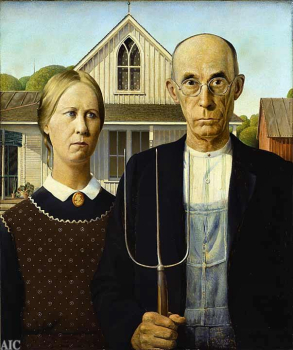
20081214roadtogreed
 Here, before us, we have a pretty
self-sufficient farm family, whose only wants outside what they produce
are some metal utensils, glass, fine cloth, perhaps, refined sugar,
flour and meal, coffee or tea. Up the hollow is a wired old coot digging
some coal and iron out of the
earth and, with his sons, building a furnace to smelt iron. Down
the road is a little country store and
water powered grist mill, where farmers can get their grains milled for
a fourth of the product. You get the picture. It's a community in early
nineteenth century Virginia or
Ohio or New York. Many dozens of places. Little or no money used
or needed. No great expectations.
Here, before us, we have a pretty
self-sufficient farm family, whose only wants outside what they produce
are some metal utensils, glass, fine cloth, perhaps, refined sugar,
flour and meal, coffee or tea. Up the hollow is a wired old coot digging
some coal and iron out of the
earth and, with his sons, building a furnace to smelt iron. Down
the road is a little country store and
water powered grist mill, where farmers can get their grains milled for
a fourth of the product. You get the picture. It's a community in early
nineteenth century Virginia or
Ohio or New York. Many dozens of places. Little or no money used
or needed. No great expectations.
How do we get from there to here in
two hundred years?
Greed came first. Men with great
ambitions turned the nation from an agrarian one to an industrial one by
mid twentieth century. Coal barons, oil barons, railroad barons, auto
barons, robber barons... Cities grew around industries and trade; poverty
and slums were their mirror images. In 1900, nine out of every ten
Americans made a living farming. Then, farming was industrialized. By 1950
only one in ten lived on farming alone.
Those who resisted these changes
were either ridiculed as utopian agrarianists or condemned as godless
communists, depending on whether they wished to turn back the clock or
share the wealth more equitably. When workers countered with an
organized labor movement, right to work laws were passed and other laws to
break the unions, and where the laws didn't work, hired thugs did the job.
The greed squad was able to turn greed into creed because: they owned
the paper and ink, the media, the newspaper and textbook companies,
companies which endowed college chairs and funded foundations which gave
grants to writers. You get the
picture. For more detail, check out A
People's History of the United States.
But the growth economy came from
two prime sources: capital G greed and all the propaganda money can buy.
style="font-family: Georgia; font-style: italic;">Guest blogger Errol is a long time social change activist. Don't miss his earlier post on Growth Economics.
Want more in-depth information? Browse through our books.
Or explore more posts by date or by subject.
About us: Anna Hess and Mark Hamilton spent over a decade living self-sufficiently in the mountains of Virginia before moving north to start over from scratch in the foothills of Ohio. They've experimented with permaculture, no-till gardening, trailersteading, home-based microbusinesses and much more, writing about their adventures in both blogs and books.
Want to be notified when new comments are posted on this page? Click on the RSS button after you add a comment to subscribe to the comment feed, or simply check the box beside "email replies to me" while writing your comment.
